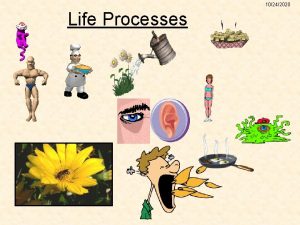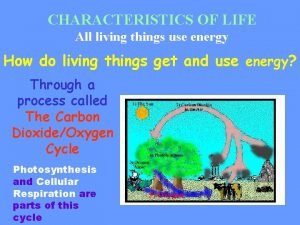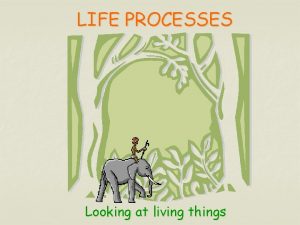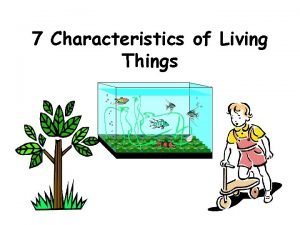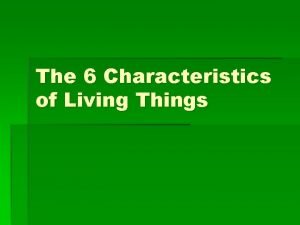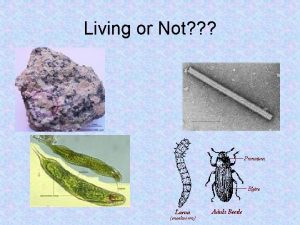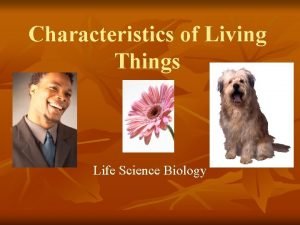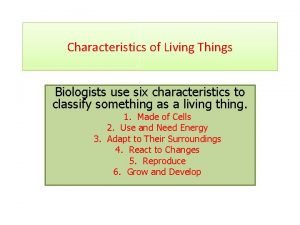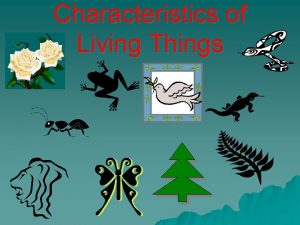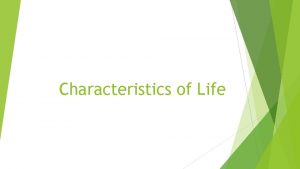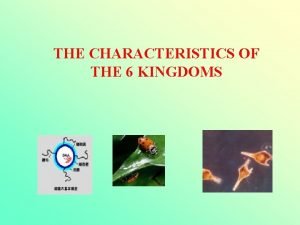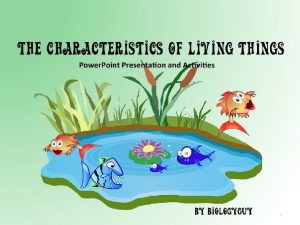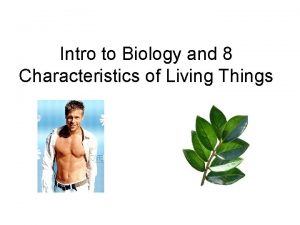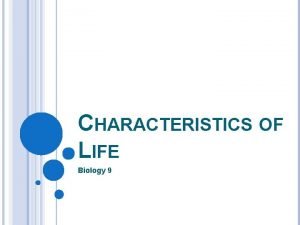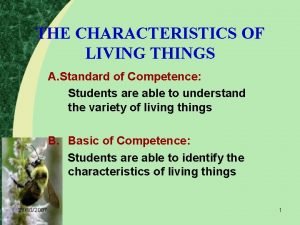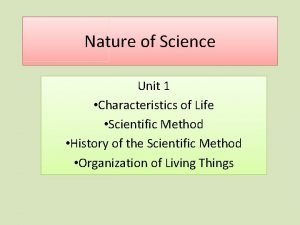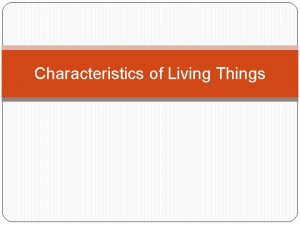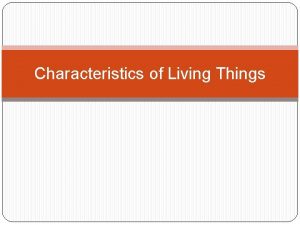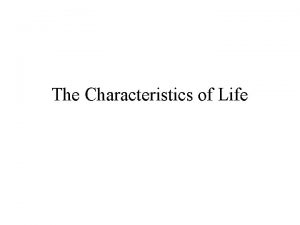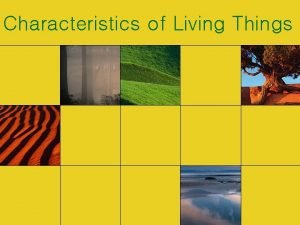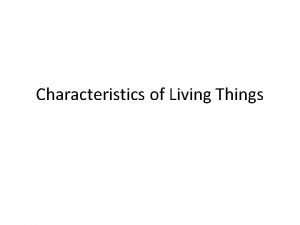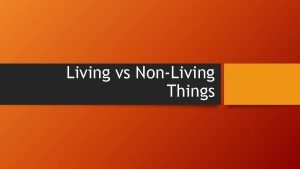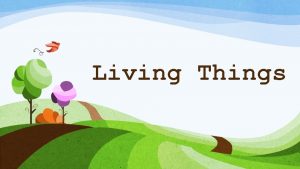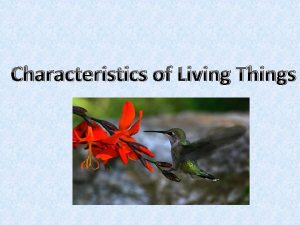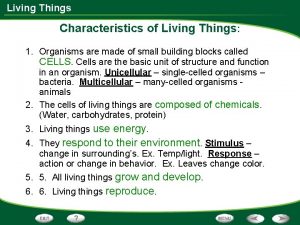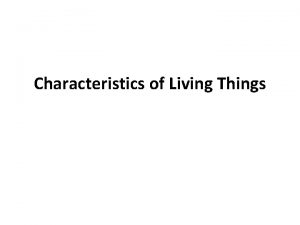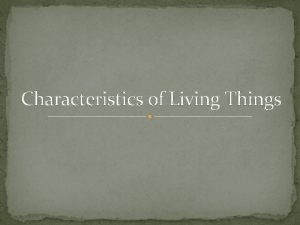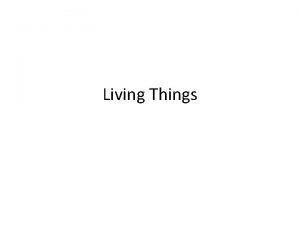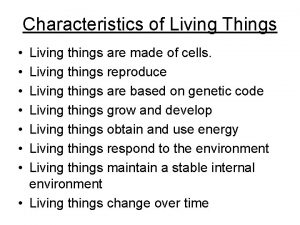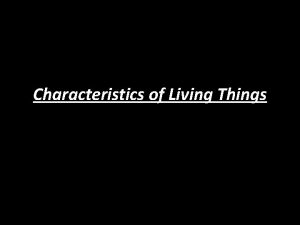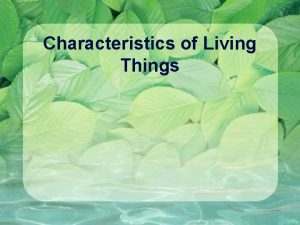Characteristics of Living Things A Characteristics of Life























- Slides: 23

Characteristics of Living Things

A. Characteristics of Life 1. All living things are organized. grow and develop, reproduce, respond, maintain certain internal conditions, and use energy. 2. Things that have all the characteristics of life are called organisms. 9/16/2020

B. Organization 1. Whether an organism is made of only one cell-the smallest unit of life-or many cells, all living things have structures that have specific functions. 2. Living things that are made of only one cell are called unicellular organisms. 9/16/2020

3. Living things that are made of two or more cells are called multicellular organisms. 4. Living things with more than one cell have a greater level of organization because groups of cells function together. 9/16/2020

C. Growth and Development 1. Living things grow by increasing cell size or increasing cell number. 2. The changes that occur in an organism during its lifetime are called development. 9/16/2020

D. Reproduction 1. Reproduction is the process by which one organism makes one or more new organisms. 2. Some organisms must have a mate to reproduce, but others can reproduce without one. 9/16/2020

E. Responses to Stimuli 1. All living things can respond to change in the environment. These changes are called stimuli and can be internal or external. 2. Hunger and thirst are examples of internal stimuli. 3. Some examples of external stimuli are light and temperature. 9/16/2020

E. Homeostasis 1. An organism’s ability to maintain stable internal conditions when outside conditions change is called homeostasis. Maintaining these conditions ensures that cells can function. 9/16/2020

2. When your outside environment becomes too hot or too cold, your body responds by sweating, shivering, or changing the flow of blood to maintain a body temperature of 37 degrees Celsius. 9/16/2020

F. Energy 1. Cells continuously use energy to transport substances, make new cells, and perform chemical reactions. 2. For most organisms, the energy they use originally came to Earth from the Sun. 9/16/2020

Question: What are some differences between living and nonliving things? 9/16/2020

All living things are organized, grow, and develop, reproduce, respond, maintain certain internal conditions, and use energy. Nonliving things do not have all these characteristics. 9/16/2020

Classifying Organisms

A. Classifying Living Things 1. There have been many different ideas about how to classify living things. 2. Aristotle placed all organisms into two large groups-plants and animals. 9/16/2020

B. Determining Kingdoms 1. Carolus Linnaeus grouped all organisms into two main kingdoms. 2. In 1969 an American biologist proposed a five-kingdom system for classifying organisms that included kingdoms Monera, Protista, Plantea, Fungi, and Animalia. 9/16/2020

C. Determining Domains 1. The current system used for classifying organisms is called systematics. Systematics uses all the information that is known about organisms to classify them. 2. Organisms are classified into one of three domains- Bacteria, Archaea, and Eukarya-then into one of six kingdoms. 9/16/2020

D. Scientific Names 1. When Linnaeus grouped organisms into kingdoms, he also developed a system for naming organisms. His system of binomial nomenclature gives each organism a two-word scientific name, such as Ursus arctos for a brown bear. *Humans are called Homo sapiens. 9/16/2020

2. A species is a group of organisms that have similar traits and are able to produce fertile offspring. 3. In a scientific name, the first word is the organism’s genus, such as Ursus. 4. The second word in the scientific name identifies the species. 9/16/2020

5. Similar species are grouped into one genus. Similar genera are grouped into families and then into orders, classes, phyla, kingdoms, and domains. 6. Each species has its own scientific name, which is the same all over the world. 9/16/2020

E. Classification Tools 1. A dichotomous key is a series of descriptions arranged in pairs that can be used to identify an unknown organism. The chosen description leads to another pair of descriptions or to the identification of the organism. 9/16/2020

2. A cladogram is a branched diagram that shows the relationships among species. New characteristics appear before each branch. 9/16/2020

Question: What are some different ways organisms can be classified? 9/16/2020

Organisms can be classified according to size, structures, cell type, habitat, the way an organism obtains food and energy, structures and functions of its features, common ancestry, or some combination of these factors. 9/16/2020
 Whats an energy pyramid
Whats an energy pyramid What is the smallest living unit
What is the smallest living unit How to remember the 7 life processes
How to remember the 7 life processes Seven life processes
Seven life processes Life cycle of all living things
Life cycle of all living things The seven life processes of living things
The seven life processes of living things 7 characteristics of life
7 characteristics of life Six characteristics of living things
Six characteristics of living things Movement characteristics of living things
Movement characteristics of living things Six characteristics of living things
Six characteristics of living things What are the six characteristics of life
What are the six characteristics of life Two characteristics of living things
Two characteristics of living things Characteristics of life
Characteristics of life Wolf kingdom classification
Wolf kingdom classification Mrs gren
Mrs gren Characteristics of animals as living things
Characteristics of animals as living things 8 characteristics of living things
8 characteristics of living things Characteristics of living things ppt
Characteristics of living things ppt 9 characteristics of life biology
9 characteristics of life biology 10 characteristics of living things
10 characteristics of living things Nature of life science
Nature of life science 7 characteristics of living things
7 characteristics of living things Is tomato living or nonliving
Is tomato living or nonliving Living non living dead
Living non living dead



